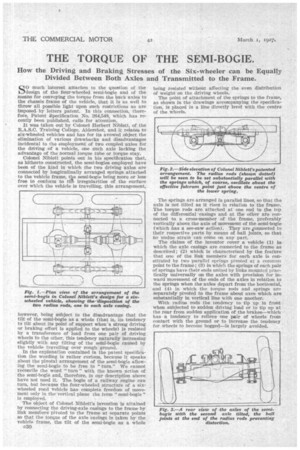THE TORQUE OF THE SEMI-BOGIE.
Page 52

If you've noticed an error in this article please click here to report it so we can fix it.
How the Driving and Braking Stresses of the Six-wheeler can be Equally Divided Between Both Axles and Transmitted to the Frame.
SC) much interest attaches to the question of the design of the four-wheeled semi-bogie and of the means for conveying the torque from the back axles to the chassis frame of the vehicle, that it is as well to throw all possible light upon such restrictions as are Imposed by letters patent. In this connection, therefore, Patent Specification No. 264,548, which has recently been published, calls for attention.
It was taken out by Colonel Herbert Niblett, of the 11.A.S.C. Training College, Aldershot, and it relates to six-wheeled vehicles and has for its avowed object the elimination of various drawbacks and disadvantages incidental to the employment of two coupled axles for the driving of a vehicle, one such axle lacking the advantage of the normal torque tube or torque stay.
Colonel Niblett points out in his specification that, as hitherto constructed, the semi-bogies employed have been of the kind in which the two driving axles are connected by longitudinally arranged springs attached to the vehicle frame, tbe semi-bogie being more or less free to conform to till irregularities of the surface over which the vehicle is travelling, this arrangement, however, being subject to the disadvantage that the tilt of the semi-bogie as a whole (that is, its tendency to tilt about its point of support when 'a strong driving or braking effort is applied to the wheels) is resisted by a transference of load from one pair of driving wheels to th,e other, this tendency naturally increasing slightly with any tilting of the semi-bogie caused by the vehicle travelling over rough ground.
In the explanation contained in the patent specification the wording is rather curious, because It speaks about the pivotal arrangement of the semi-bogie allowing the semi-bogie to be free to "turn." We cannot reconcile the word 'turn" with the known action of the semi-bogie and, therefore, in our description above have not used it. The bogie of a railway engine can turn, but because the four-wheeled structure of a sixwheeled road vehicle has complete freedom of movement only in the vertical plane the term "semi-bogie" is employed. •
• The object of Colonel NibleWs invention is attained by connecting the driving-axle casings to the frame by link members pivoted to the frame at separate points so that the torque of the axle 'casings is taken by the vehicle frame, the tilt of the semi-begin as a whole e30 being resisted without affecting the even distribution of weight on the driving wheels.
The point of attachment of the springs to the frame, as shown ia the drawings accompanying the specification, is placed in a line directly level with the centre of the wheels.
The springs are arranged in parallel lines, so that the axle is not tilted as it rises in relation to the frame. The torque rods are attached at one end to the top of the differential 'casings and at the other are connected to a cross-member of the frame, preferably vertically above the axis of movement of the semi-bogie (which has a see-saw action). They are connected to their respective parts by means of ball joints, so that no undue strain can come on any part.
The claims of the inventor cover a vehicle (1) inwhich the axle casings are connected to the frame as described ; (2) which is characterized by the featUre that one of the link members for each axle is constituted by two parallel springs pivoted at a common point to the frame ; (3) in which the springs of each pair of springs have their ends united by links mounted practically universally on the axles, with provision for inward movement of the ends of the axles in relation to the springs when the axles depart from the horizontal, and (4) in which the torque rods and springs are separately pivoted to the frame about axes which are substantially in vertical line with one another.
With radius rods the tendency to tip up in front • when subjected to sudden driving load or to tip up at the rear from sudden application of the brakes—which has a tendency to relieve one pair of wheels from contact with the ground or to increase the tendency for wheels to become bogged—is largely avoided.












































































































